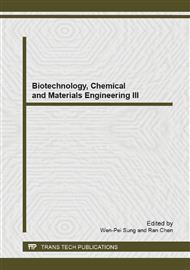[1]
V. Alonso, A. Martin, R. Borja, A. Chica: Environmental Technol Vol. 14 (1993), P. 1145.
Google Scholar
[2]
H.H. Nimz, in: A. Pizzi (Ed. ), Wood Adhesives: Chemistry and Technology Vol. 1, Dekker, New York (1983), p.247.
Google Scholar
[3]
Funaoka M, Matsubara M, Seki N, Fukatsu S. Conversion of native lignin to a highly phenolic functional polymer and its separation from lignocellulosics. Biotechnol Bioeng(1995), 46(6), pp.545-552.
DOI: 10.1002/bit.260460607
Google Scholar
[4]
Matsushita Y, Yasuda S. Reactivity of a condensed-type lignin model compound in the Mannich reaction and preparation of cationic surfactant from sulfuric acid lignin. J Wood Sci(2003), 49(2), pp.166-171.
DOI: 10.1007/s100860300026
Google Scholar
[5]
Zhou MS, Qiu XQ, Yang DJ, Lou HM, Ouyang XP. Highperformance dispersant of coal-water slurry synthesized from wheat straw alkali lignin. Fuel Process Technol(2007), 88(4), pp.375-382.
DOI: 10.1016/j.fuproc.2006.11.004
Google Scholar
[6]
Goncalves AR, Benar P. Hydroxymethylation and oxidation of Organosolv lignins and utilization of the products. Bioresour Technology (2001), 79(2), pp.103-111.
DOI: 10.1016/s0960-8524(01)00056-6
Google Scholar
[7]
Yong Sun, Xueqing Qiu, Yunquan Liu. Chemical reactivity of alkali lignin modified with laccase. Biomass and Bioenergy Vol. 55(2013), pp.198-204.
DOI: 10.1016/j.biombioe.2013.02.006
Google Scholar
[8]
R. Singh, S. Singh, K.D. Trimukhe, K.V. Pandare, K.B. Bastawade, D.V. Gokhale, A.J. Varma. Lignin–carbohydrate complexes from sugarcane bagasse: Preparation, purification, and characterization. Carbohydrate Polymers Vol. 62 (2005), pp.57-66.
DOI: 10.1016/j.carbpol.2005.07.011
Google Scholar
[9]
Wu Shufang, You Jixue. Changes of lignin and carbohydrate in alkaline wheat straw pulp after xylanase treatment. Jounal of cellulose science and technology(2002), Vol. 6, pp.43-46.
Google Scholar
[10]
Miller, G.L., Use of dinitrosalicylic acid reagent for determination of reducing sugar. Anal. Chem. Vol. 31(1959), pp.426-428.
DOI: 10.1021/ac60147a030
Google Scholar
[11]
Yang Shuhui. Plant fibre science. China light industry press (2001), pp.114-116.
Google Scholar
[12]
A. Scalbert, B. Monties, E. Guittet, J.Y. Lallemand, Holzforschung, Vol. 40(1986), p.119.
DOI: 10.1515/hfsg.1986.40.2.119
Google Scholar
[13]
B. Xiao, X.F. Sun, RunCang Sun. Chemical, structural, and thermal characterizations of alkali-soluble lignins and hemicelluloses, and cellulose from maize stems, rye straw, and rice straw. Polymer Degradation and Stability Vol. 74(2001).
DOI: 10.1016/s0141-3910(01)00163-x
Google Scholar
[14]
J.G. Buta, F. Zadrazil, G.C. Galletti, J. Agric. Food Chem. Vol. 37 (1989), p.1382.
Google Scholar


